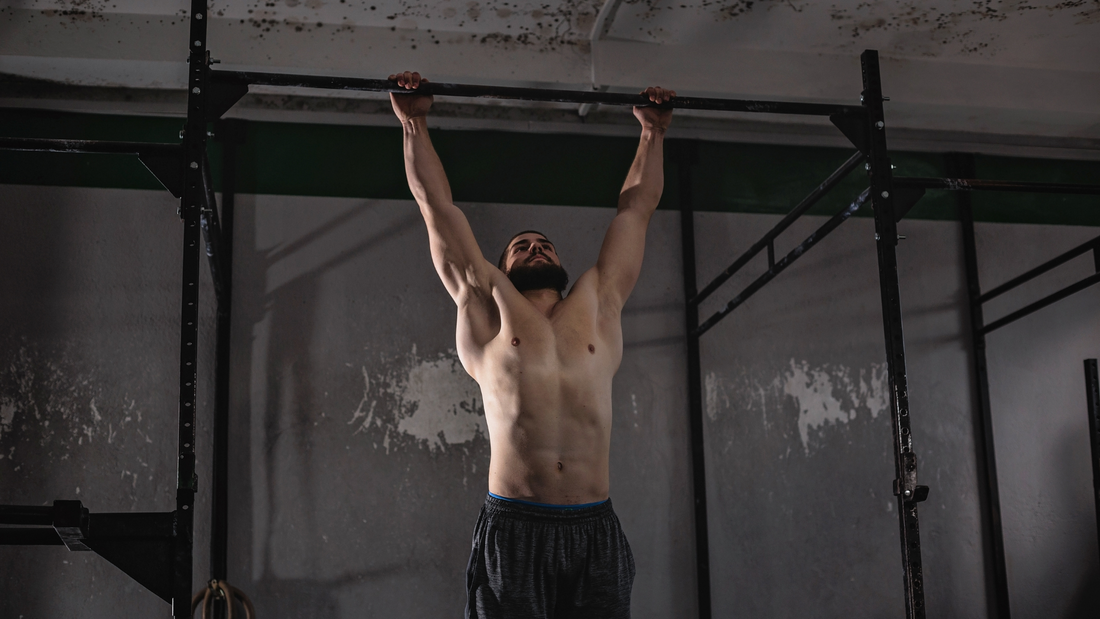In the fitness world, hanging exercises might not be as widely discussed as running, lifting weights, or yoga, but these exercises offer a multitude of health benefits that can contribute to your overall fitness and well-being. Let's take a look at the various health advantages of hanging exercises, exploring their impact on the musculoskeletal system, cardiovascular health, mental well-being, and more.
Hanging exercises involve suspending your body from a bar (or other object), allowing gravity to work on your body. The most common form of hanging exercise is the dead hang, where you simply hang from a bar with your arms fully extended. Variations include hanging leg raises, chin ups, pull-ups, and other movements that incorporate hanging as a foundational position. Here are some of the benefits hanging exercises have to offer:
-
Spinal Decompression: One of the most significant benefits of hanging exercises is spinal decompression. Throughout the day, gravity compresses the spine, leading to discomfort and potential long-term issues like herniated discs or chronic back pain. Hanging from a bar helps to counteract this compression. The act of hanging stretches the spine, allowing the intervertebral discs to rehydrate and regain their natural spacing. This can alleviate pressure on the spinal nerves and reduce pain.
-
Improved Posture: Poor posture is a common issue, often resulting from sitting for long periods and inadequate physical activity. Hanging exercises can help correct this by strengthening the muscles involved in maintaining proper posture. The act of hanging engages the back, shoulder, and core muscles, which play a crucial role in keeping the spine aligned.
-
Shoulder Mobility and Strength: The shoulders are complex joints that require both mobility and strength to function optimally. Hanging exercises are particularly effective for enhancing shoulder mobility. When you hang from a bar, the shoulder joints are subjected to a gentle stretching force, which can increase their range of motion. Additionally, the muscles surrounding the shoulders, such as the rotator cuff and deltoids, are activated and strengthened. This combination of mobility and strength can improve overall shoulder function and reduce the risk of injuries.
-
Engaging the Core Muscles: Hanging exercises, especially pull ups, are excellent for building core strength. When you hang from a bar, your core muscles, including the rectus abdominis, obliques, and transverse abdominis, must work to stabilize your body. This is especially true for dynamic hanging exercises like leg raises or windshield wipers. A strong core is essential for overall stability, balance, and functional movement.
-
Enhanced Grip Strength: Grip strength is often overlooked, but it plays an important role in many activities, and hanging exercises are one of the most effective ways to develop grip strength. Holding onto a bar requires significant forearm and hand strength, and over time this can lead to improved performance in other exercises, such as weightlifting, climbing, and even daily tasks like carrying groceries. Grip strength has also been shown to be a predictor of future outcomes in ageing populations.
- Increased Flexibility: Flexibility is an often overlooked aspect of fitness, yet it is crucial for overall health and performance. Hanging exercises can contribute to increased flexibility, particularly in the shoulders, spine, and hips. The stretching and lengthening of muscles during hanging promote greater flexibility and range of motion, which can enhance overall athletic performance and reduce the risk of injuries.
Practical Tips and Variations.
Whether you're looking to decompress your spine with a dead hang, strengthen your core with hanging leg raises, or test your grip strength with pull, below we'll go over some detailed instructions to help you get the most out of these movements.
-
The dead hang is the simplest and most foundational hanging exercise. To perform a dead hang, grip a pull-up bar with your palms facing either toward or away from you, and simply hang with your arms fully extended. This exercise is excellent for spinal decompression, grip strength, and shoulder mobility. Aim to hold the position for as long as possible, gradually increasing your hang time as you progress.
-
Hanging leg raises are a dynamic variation that targets the core muscles. To perform this exercise, hang from a bar and lift your legs until they are parallel to the ground or higher, and then lower again. Keep your legs straight or bend your knees to modify the difficulty. This exercise challenges the core and hip flexors, contributing to overall core strength and stability.
-
Pull-ups and chin-ups are classic exercises that incorporate hanging as a starting position. These exercises primarily target the upper body, including the back, shoulders, and arms. By varying your grip (overhand for pull-ups, underhand for chin-ups), you can emphasize different muscle groups. These exercises are excellent for building upper body strength and muscle mass.
- Windshield wipers are an advanced hanging exercise that requires significant core strength and control. To perform this exercise, hang from a bar and lift your legs to one side, then slowly move them to the other side in a controlled manner, resembling the arcing motion of windshield wipers. This exercise engages the entire core, obliques, and hip flexors, providing a challenging and effective workout.
Safety and Considerations.
While hanging exercises offer numerous benefits, it is essential to perform them safely to avoid injury. Always warm up your muscles before performing hanging exercises. This can include dynamic stretches or light cardio to increase blood flow and prepare your body for the workout. If you are new to hanging exercises, start with a grip that feels comfortable and gradually work on improving your grip strength. Using grip aids, such as chalk or wrist straps, can help if you struggle with holding onto the bar. Maintain proper form throughout the exercise to avoid unnecessary strain on your joints and muscles. Keep your shoulders engaged and avoid excessive swinging or kipping unless you are performing specific variations that require it. Start with basic exercises, such as the dead hang, and gradually progress to more challenging variations as your strength and endurance improve. Listen to your body and avoid overexertion.
Hanging exercises are a versatile and effective addition to any fitness routine. They offer a wide range of health benefits, from spinal decompression and improved posture to enhanced core strength and cardiovascular endurance. Additionally, hanging exercises can contribute to stress relief, neurological function, and overall athletic performance. By incorporating these exercises into your regular workout regimen, you can experience the numerous advantages they provide, leading to better physical health and well-being.
Whether you are a seasoned athlete or a fitness enthusiast looking to diversify your routine, hanging exercises are worth considering. Start with the basics and gradually progress to more advanced variations, always prioritizing safety and proper form. With consistent practice, you will reap the rewards of this unique and beneficial form of exercise, improving your strength, flexibility, and overall quality of life.

